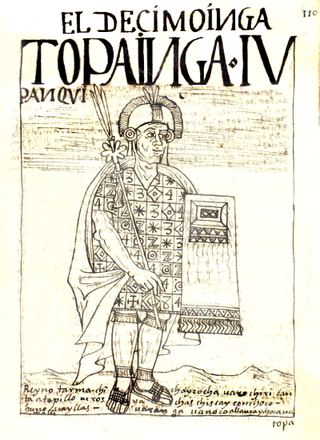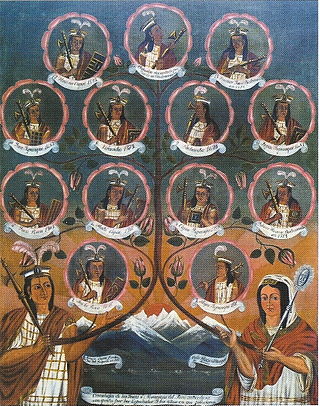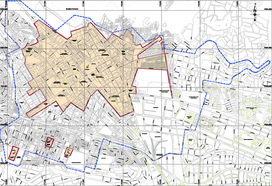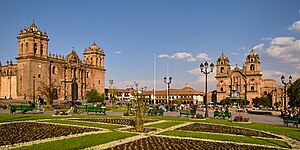
The Inca Empire, called Tawantinsuyu by its subjects, was the largest empire in pre-Columbian America. The administrative, political, and military center of the empire was in the city of Cusco. The Inca civilization rose from the Peruvian highlands sometime in the early 13th century. The Spanish began the conquest of the Inca Empire in 1532 and by 1572, the last Inca state was fully conquered.

Túpac Amaru was the last Sapa Inca of the Neo-Inca State, the final remaining independent part of the Inca Empire. He was executed by the Spanish following a months-long pursuit after the fall of the Neo-Inca State.

Cusco or Cuzco is a city in southeastern Peru near the Urubamba Valley of the Andes mountain range. It is the capital of the Cusco Region and of the Cusco Province. The city is the seventh most populous in Peru; in 2017, it had a population of 428,450. Its elevation is around 3,400 m (11,200 ft).

Manco Cápac, also known as Manco Inca and Ayar Manco, was, according to some historians, the first governor and founder of the Inca civilization in Cusco, possibly in the early 13th century. He is also a main figure of Inca mythology, being the protagonist of the two best known legends about the origin of the Inca, both of them connecting him to the foundation of Cusco. His main wife was his older sister, Mama Uqllu, also the mother of his son and successor Sinchi Ruq'a. Even though his figure is mentioned in several chronicles, his actual existence remains uncertain.

Pachacuti Inca Yupanqui, also called Pachacutec, was the ninth Sapa Inca of the Kingdom of Cusco which he transformed into the Inca Empire. Most archaeologists now believe that the famous Inca site of Machu Picchu was built as an estate for Pachacuti.

Atahualpa, also Atawallpa (Quechua), Atabalica, Atahuallpa, Atabalipa, was the last effective Incan emperor before his capture and execution during the Spanish conquest.

Huayna Capac was the third Sapa Inca of Tawantinsuyu, the Inca Empire. He was the son of and successor to Túpac Inca Yupanqui., the sixth Sapa Inca of the Hanan dynasty, and eleventh of the Inca civilization. He was born in Tumipampa and tutored to become Sapa Inca from a young age.

Sinchi Roca, Sinchi Rocca, Cinchi Roca, Sinchi Ruq'a or Sinchi Ruq'a Inka was the second Sapa Inca of the Kingdom of Cusco and a member of the Hurin dynasty.

Manco Inca Yupanqui was the founder and monarch of the independent Neo-Inca State in Vilcabamba, although he was originally a puppet Inca Emperor installed by the Spaniards. He was also known as "Manco II" and "Manco Cápac II". He was one of the sons of Huayna Capac and a younger brother of Huascar.

Topa Inca Yupanqui or Túpac Inca Yupanqui, translated as "noble Inca accountant," was the tenth Sapa Inca (1471–93) of the Inca Empire, fifth of the Hanan dynasty. His father was Pachacuti, and his son was Huayna Capac. Topa Inca belonged to the Qhapaq panaca. His qoya was his older sister, Mama Ocllo.

The Sapa Inca was the monarch of the Inca Empire (Tawantinsuyu), as well as ruler of the earlier Kingdom of Cusco and the later Neo-Inca State. While the origins of the position are mythical and originate from the legendary foundation of the city of Cusco, it seems to have come into being historically around 1100 AD. Although the Inca believed the Sapa to be the son of Inti and often referred to him as Intip Churin or 'Son of the Sun,' the position eventually became hereditary, with son succeeding father. The principal wife of the Inca was known as the Coya or Qoya. The Sapa Inca was at the top of the social hierarchy, and played a dominant role in the political and spiritual realm.

The Incas were most notable for establishing the Inca Empire which was centered in modern day South America in Peru and Chile. It was about 2,500 miles from the northern to southern tip. The Inca Empire lasted from 1438 to 1533. It was the largest Empire in America throughout the Pre-Columbian era. At the peak of the Inca Empire, it was the largest nation in the world and to this day is the largest native state in the western hemisphere. The Inca civilization was located from north to south of the western hemisphere of South America. The Inca state was known as the Kingdom of Cuzco before 1438. Over the course of the Inca Empire, the Inca used conquest and peaceful assimilation to incorporate the territory of modern-day Peru, followed by a large portion of western South America, into their empire, centered on the Andean mountain range. However, shortly after the Inca Civil War, the last Sapa Inca (emperor) of the Inca Empire was captured and killed on the orders of the conquistador Francisco Pizarro, marking the beginning of Spanish rule. The remnants of the empire retreated to the remote jungles of Vilcabamba and established the small Neo-Inca State, which was conquered by the Spanish in 1572.

The Inca army was the multi-ethnic armed forces used by the Tawantin Suyu to expand its empire and defend the sovereignty of the Sapa Inca in its territory.

The Kingdom of Cusco, also called the Cusco confederation, was a small kingdom based in the Andean city of Cusco that began as a small city-state founded by the Incas around the start of 13th century. In time, through warfare or peaceful assimilation, it began to grow and was succeeded by the Inca Empire (1438–1533).

The Cathedral of Cusco or Cathedral Basilica of the Virgin of the Assumption is the main temple of the city of Cusco, in Peru and houses the headquarters of the Archdiocese of Cusco. The Cathedral Basilica of Cusco, together with the Triunfo temple make up the Cathedral Complex, it is located in the northeast sector of the current Plaza de Armas of Cusco. In the place that, during the Inca period, was occupied by both the Suntor Wassi and the Kisoarkancha or Palace of the eighth Inca Viracocha. The complex occupies an area of 3,920 square meters and is the most important religious monument in the Historic Center of Cusco.

The history of Cusco (Peru), the historical capital of the Incas.
Auqui was the title held by the crown prince in the Inca Empire or Tahuantinsuyu. In a generic way, all the male children of the Inca were called auquis; however, the specific title was applicable only to one of them, whose choice was based on criteria different from those of the Eastern world because his capacity was taken into account, rather than his status as first-born or legitimate son.

The Monument to Manco Cápac is a statue located in the homonymous square in La Victoria District, Lima, the work of the Peruvian sculptor David Lozano, inaugurated in 1926.
Capac Yupanqui, was the brother of the Inca emperor Pachacuti and an Inca general.

Amaru Topa Inca, also known as Amaru Inca Yupanqui, was an Inca prince and co-ruler of the Hanan dynasty, who reigned around 1450. He was the son of Pachacuti and Mama Anawarki. Around 1450, Pachacuti decided to name him his co-ruler and successor. His reign lasted between five and ten years.
























